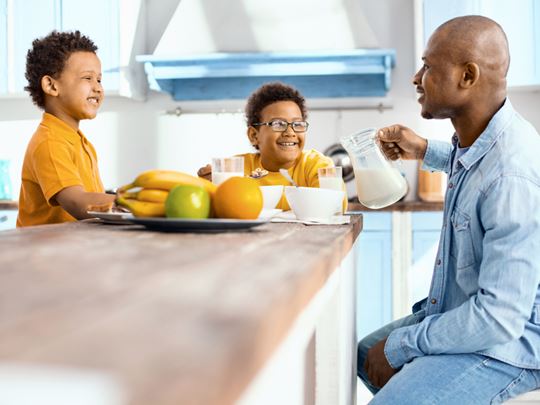Whether you’re excited, nervous, or something in between, welcoming a foster child into your home can be a daunting experience. So, we’ve spoken to foster parents and created this guide to give you some ideas on how to help your foster child settle into their new home.
How to make a foster child feel welcome
When foster children arrive at a new home, they have already been through a lot and are stepping into the unknown, which can be a frightening and stressful experience. Here are a few practical tips to help them feel at ease and welcome.

Create a welcome basket
When children move into foster care, they often have to leave their belongings behind. This means they may not have everything they need on arrival and could initially feel embarrassed or afraid to ask for items they require. Creating a welcome basket will ease their anxiety about being without their belongings and ensure they feel comfortable in their new home.
One of our foster parents said, “Welcome baskets for the children are a good idea. We include some basics like a hairbrush, toothpaste, toothbrush, pants, socks, a towel, colouring books, a pencil case and pens.”
If you’re fostering a teenager, you could include sanitary towels, tampons, shampoo, conditioner and deodorant. You could also swap the colouring books for a notepad and include age-appropriate novels, magazines, games, snacks and a bottle of water.
Create a welcome book
When your foster child moves in, they may feel overwhelmed by all the new faces and struggle to learn everyone’s name. Consider creating a welcome book, including names and photos of family members and a little introduction from everyone. Don’t forget to include your pets and a funny story about them so your foster child feels connected to their new furry friend. You could pop the welcome book in your foster child’s welcome basket or leave it in their room to look at when they’re ready.
Use stickers to ease anxiety
When your foster child arrives, they might have difficulty remembering your name and the house layout as they adjust to their new surroundings and process their situation. To help with this, you could label the doors of each room so they can navigate their way around and wear name tags so they don’t forget your name. You could also use place cards during mealtimes so they know where to sit.
Create a meal plan
Mealtimes can be a source of anxiety for children and young people in foster care. They may have experienced neglect, not knowing when they’d have their next meal, they could have food sensory issues or struggle to try new foods.
You can help your foster child feel welcome and ease concerns about food by creating and displaying a meal plan with timings so they know when their next meal will be and what they’ll eat. Ask your foster child about their favourite meals, and include these in your meal plan so they feel part of the family and know they’ll enjoy their meal. You could also have a box of healthy snacks available for them to dip into throughout the day without needing to ask you first.

Let them personalise their space
Whether you foster a child short-term or long-term, their bedroom will become their safe haven where they can relax, unwind and surround themselves with things that make them feel comfortable. So, although your spare bedroom will need some preparation for their arrival, it’s a good idea to hold off on decorating until your foster child arrives.
One of our foster parents said, ‘Don’t go out and buy bedding and assume that they’ll like whatever it is that you’ve picked. Do all of that once they arrive.’
You could take them on a shopping trip and help them choose the paint colour for their walls and some accessories like bedding. Not only will this help your foster child feel welcome, but it’s also a brilliant opportunity to bond and discover their likes and dislikes.
If you’re fostering a child with disabilities, make sure your house and their room are fit for their needs; for example, if they have sensory issues, their bedroom should be a calm and tranquil place to prevent overstimulation.
Have a family photo
If your foster child feels comfortable with having their photo taken, you could involve them in a family photo and put pictures of them on the walls so they feel like an intricate part of the family. If they are a keen artist or create drawings at school, display them proudly on the fridge to boost their confidence and demonstrate that you’re proud of their creations.
Include them in chores
It may not sound welcoming, but including your foster child in daily chores will give them responsibility and help them feel effective within the family home. If you have other children, it could also put them at ease knowing their new sibling will have to do chores just like them. If you foster a young child, they could help you load the dishwasher, and older children can help with the vacuuming. Create a schedule so they know which chore they are responsible for each day and praise their efforts.
Organise some family activities
Family activities are a lovely way to help your foster child feel welcome and part of the family. When they are settling in, start small by having a game and movie night or walking the dog together. In the summer, you could ask them to help you pick some plants for the garden and spend the day planting them together. Knowing they’ve contributed to your beautiful garden will help them feel at home. As they feel more settled, you could plan a family day out and create lasting memories together.

Talk to other foster families
When you foster with FCA, you’ll be supported by a network of foster families and fostering experts who can provide more guidance on how to welcome a foster child. Our support for children in foster care will help your young person settle in, and they’ll have opportunities to make new friends through our events, activities and support groups.
If you’re thinking about fostering a child and would like more information on preparing for your first foster child or the types of fostering we offer, enquire today.





